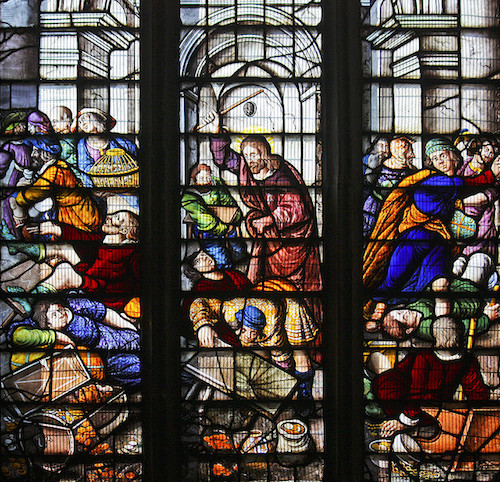We run our website the way we wished the whole internet worked: we provide high quality original content with no ads. We are funded solely by your direct support. Please consider supporting this project.

The Cleansing of the Temple and Non-Violence
Jesus’ cleansing of the Temple is the most commonly cited example of those who allege that he did not absolutize loving enemies or refraining from violence. I submit that this episode implies nothing of the sort. First, it is important that we understand that this episode was not an expression of unpremeditated anger on Jesus’ part, as some allege. Most NT scholars concur that this was a calculated, strategic act on Jesus’ part, and it contained deep symbolic significance. More specifically, this episode appears to be a classic example of a prophetic symbolic action.
There is, however, some disagreement over what exactly Jesus was symbolizing. For example, many argue that Jesus was revealing himself to be the long-awaited messiah who was widely expected to cleanse and/or restore the Temple. Others argue that Jesus was symbolically revealing Yahweh’s displeasure with the corrupt religious establishment and issuing a prophetic warning that the Temple would soon be destroyed, a point that John makes explicit (Jn 2: 19-22). While interpretations differ, however, they all presuppose that the Temple cleansing was anything but a spontaneous tantrum on the part of Jesus.
Second, there is simply no indication in any of the Gospels that Jesus resorted to violence when he cleansed the Temple. Yes, the texts suggest that Jesus was angry, and yes, John tells us that Jesus made a whip (Jn 2:15). But there is no suggestion that he used it to strike any animal or person. To the contrary, throughout history cracking a whip has been a commonly used means of controlling the movement of animals, and John explicitly reports that this is what Jesus used it for. He used the whip to create an animal stampede of “both sheep and cattle” out of the “temple courts” (Jn 2:15). Not only this, but had Jesus actually whipped any of the court officials, it is hard to imagine how he could have avoided being arrested on the spot. It is also hard to imagine how he could have avoided the charge of hypocrisy, for such behavior would have flown in the face of his previously mentioned public teachings about refraining from violence.
There is therefore nothing about Jesus’ cleansing of the temple that runs counter to my claim that the non-violent, enemy-embracing, self-sacrificial love that was supremely revealed on the cross is the thematic center of Jesus’ identity and mission. To the contrary, Jesus engaged in a kind of “street theater” out of love for his “Father’s house” as well as for the poor who were being oppressed by the corrupt leaders who ran the Temple’s “buying and selling” system. And, as the Gospels make clear, he confronted these leaders in this aggressive manner as a way of forcing their hand, and thus as a steppingstone to his crucifixion. Far from illustrating Jesus acting in an unloving, let alone violent way, I submit that this entire episode reflects Jesus’ self-sacrificial love.
Moreover, John explicitly makes the cross the thematic center of this episode, for he records that Jesus brings this episode to a close by drawing a connection between the newly cleansed temple, which Jesus prophesied would soon be permanently destroyed, and his own body, which would rise again three days after being destroyed (Jn 2:19-22). Read in context, NT scholar Richard Hays notes, John is declaring “that Jesus’ body is now the place where God dwells, the place where atonement for sin occurs, the place where the division between God and humanity is overcome.” Hence, far from counting against the thematic centrality of the cross, the Temple cleansing illustrates this centrality.
Photo credit: Lawrence OP via VisualHunt.com / CC BY-NC-ND
Category: General
Tags: Cross, Love, Non-Violence
Topics: Enemy-Loving Non-Violence
Related Reading

Judgment and Idolatry
Why was the forbidden tree in the center of the garden called The Tree of the Knowledge of Good and Evil? Since the Bible depicts eating from this tree as the reason humans are estranged from God and the cause of all that’s wrong with humanity, eating from this tree is obviously a terrible thing.…

Henry’s Mom: Did God Author This?
Many of you were touched last month when we featured some reflections on little Henry’s death. Well, Henry’s mother Jess has started a blog to process through some of her thoughts and we wanted to share this amazing piece with all of you. Jess thinks ahead to the time when her two-year-old daughter will start…

Is A Non-violent Jesus in Revelation A New View?
In this Q and A from Greg Boyd’s series on the book of Revelation, someone asked if the view that Jesus is a non-violent “lamb” a new view? You can view the full Q and A HERE.

Homosexuality and the Church: Finding a “Third Way”
Here is a word I a shared this last weekend with Woodland Hills Church (where I’m senior pastor) in response to numerous questions I’ve received over the last several months. People have asked me why the leadership of WHC refuses to jump on the bandwagon of evangelical churches in the Twin Cities who rally their…

The Greatest Love Story Ever Told
This is the first week of Advent, the season where we anticipate the coming of Christ. It’s a time to hear and enter into the story of how Jesus came out of love to give his life for us. This grand love story of Christmas taps into a deep intuition we have about the centrality…

ISIS, Islam & Jesus
http://youtu.be/7W5NWWFFJMg?list=PLB5r2P47beqLlY3wM6VKjwEEofXAZ4lX5 Our friend Bruxy taught a series at The Meeting House titled ISIS, Islam & Jesus that we wanted to share with you. This is episode one, and you can find the whole series by clicking here. If you believe in redemptive violence, you’ll be challenged by what he has to say.
